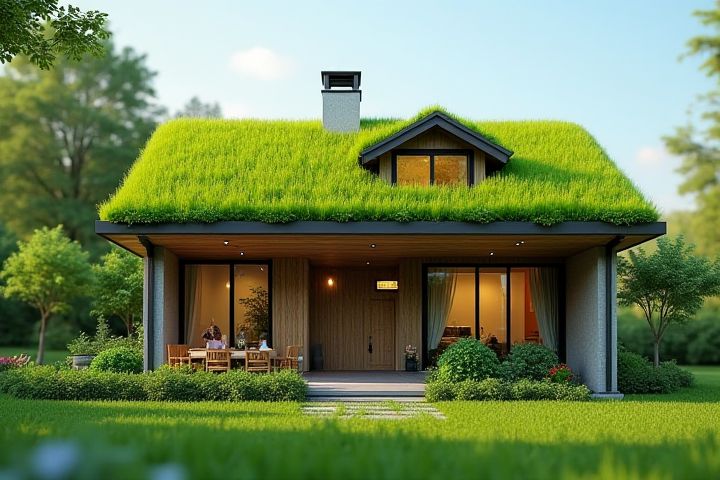
A house can indeed have a green roof, which consists of a layer of vegetation planted over a waterproof membrane, designed to provide insulation and manage stormwater. This eco-friendly architectural feature offers numerous benefits, such as reducing energy costs, improving air quality by filtering pollutants, and providing a natural habitat for wildlife. Green roofs also contribute to urban heat reduction, making cities cooler while enhancing the aesthetic appeal of buildings. Homeowners can choose various plant species, including sedums or native grasses, that thrive in specific climates and require minimal maintenance. By implementing a green roof, you not only increase the value of your property but also contribute positively to environmental sustainability.
Can A House Have A Green Roof
Environmental benefits
A house with a green roof significantly enhances environmental sustainability by reducing urban heat islands, leading to lower energy consumption for cooling. This living roof system acts as a natural insulator, maintaining more stable indoor temperatures and decreasing reliance on air conditioning. Furthermore, green roofs improve air quality by filtering pollutants and absorbing carbon dioxide, contributing to cleaner urban environments. By capturing rainwater, they also mitigate stormwater runoff, which helps prevent flooding and water pollution in surrounding areas.
Energy efficiency
A green roof can significantly enhance a house's energy efficiency by providing natural insulation, which helps to regulate indoor temperatures. Studies show that these roofs can reduce heating costs by up to 25% in winter and cooling costs by as much as 75% in summer. The vegetation absorbs sunlight, minimizing heat gain and creating a cooling effect through evapotranspiration. Implementing a green roof also contributes to lower urban heat island effects, improving overall environmental sustainability.
Stormwater management
A green roof, composed of layers of vegetation and growing medium, significantly enhances stormwater management by absorbing, retaining, and filtering rainwater. Research indicates that a green roof can retain approximately 40% to 90% of precipitation, depending on the plant species and design, mitigating urban flooding. Additionally, it helps reduce the volume of stormwater runoff, which can decrease the load on municipal sewer systems during heavy rainfall events. Implementing a green roof not only improves water management but also contributes to energy efficiency, biodiversity, and air quality.
Biodiversity enhancement
A green roof can significantly enhance biodiversity by providing a habitat for various species, including birds, insects, and plants. With a well-planned layout, you can create microhabitats that support native flora and fauna, promoting ecological balance. Studies reveal that green roofs can increase urban biodiversity by as much as 20% compared to traditional roofs. By incorporating a diverse range of plants, such as succulents and flowering species, a green roof fosters pollinator populations, encouraging a thriving ecosystem right at your home's top.
Urban heat reduction
A green roof can significantly contribute to urban heat reduction by providing natural insulation and evaporative cooling. By incorporating vegetation, these roofs absorb sunlight, reducing surface temperature and minimizing the urban heat island effect. In addition to decreasing ambient temperatures, green roofs improve air quality and promote biodiversity within urban environments. You can enhance energy efficiency in your building while supporting sustainable urban development through the installation of a green roof.
Increased property value
A green roof can significantly enhance your property's value, with studies showing an increase of 15% to 25% in market appeal. This eco-friendly feature not only improves energy efficiency by providing natural insulation but also contributes to stormwater management, reducing runoff by up to 50%. Homes with green roofs can attract environmentally-conscious buyers, making your property more desirable in today's market. Moreover, these roofs can extend your roof's lifespan by up to two times, ultimately saving you money on maintenance and repairs.
Structural considerations
A green roof can significantly enhance a house's sustainability, but it requires careful structural planning. The additional weight of soil, vegetation, and moisture can range from 15 to 150 pounds per square foot, necessitating reinforcement of the building's load-bearing elements. Proper drainage systems must also be integrated to prevent water accumulation, ensuring the structural integrity remains intact. Before installation, a thorough assessment by a structural engineer can provide tailored solutions that account for your home's specific design and local climate conditions.
Insulation properties
A green roof can significantly enhance a house's insulation properties, reducing energy costs by up to 30%. The layers of soil and vegetation on a green roof provide excellent thermal mass, which helps regulate indoor temperatures throughout the year. During summer months, plants absorb heat and reduce the need for air conditioning, while in winter, the added insulation minimizes heat loss, contributing to a cozier indoor environment. Your investment in a green roof can also increase the overall value of your home by promoting energy efficiency and sustainability.
Maintenance requirements
A house with a green roof requires specific maintenance to ensure its longevity and effectiveness. Regular inspection of the vegetation for pests and diseases is essential; this helps maintain healthy plants that contribute to insulation and carbon capture. During dry spells, you may need to irrigate the green roof to prevent stress on the plants, while also ensuring proper drainage systems are in place to avoid excess water accumulation. Seasonal tasks include pruning, fertilizing, and removing debris, which collectively support the ecological functions of the green roof and enhance its aesthetic appeal.
Local regulations
Many local regulations support the installation of green roofs due to their environmental benefits, such as reducing stormwater runoff and improving air quality. In urban areas, municipalities may require permits or adherence to specific guidelines to ensure structural integrity and compliance with safety standards. Homeowners must check zoning laws, which can dictate vegetation types and maintenance responsibilities. Engaging with local building departments can provide essential insights into potential incentives or financial assistance for implementing a green roof solution.
